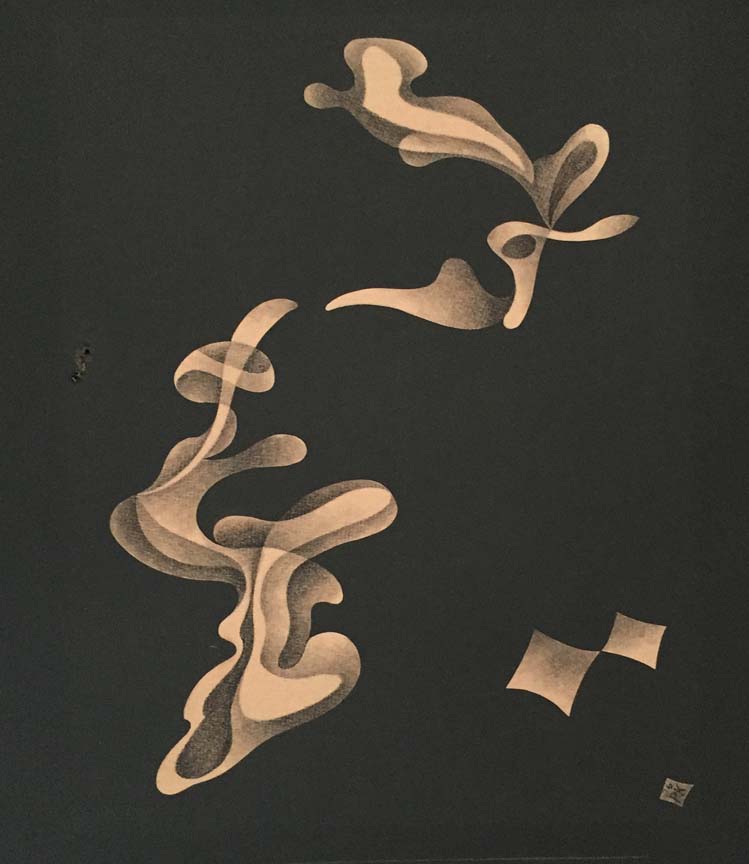

PAUL KELPE
"ABSTRACT #2"
PENCIL, MIXED MEDIA, SIGNED
GERMAN/AMERICAN, DATED 1936
12 X 10 INCHES
Paul Kelpe 1902-1985 Paul Kelpe was a German-born American abstract painter. His constructions integrating found objects into paintings were the first such works created in the United States and he painted two of the five Williamsburg murals, the first abstract murals in the United States. In addition to his mural work for various American government projects, he was an innovative independent painter and university art professor. He was a pioneer of American abstract art, including his work in Chicago during a period in which abstracts were not well accepted or appreciated. Kelpe’s artistic training in Germany included studies with Wassily Kandinsky and László Moholy-Nagy, and he encountered art by other modernists including Kurt Schwitters, Naum Gabo, and El Lissitzky. He became familiar with prominent European modernist movements of the time such as Suprematism and Constructivism. Schwitters in particular proved to be a major influence, but Kelpe, eschewing what he viewed as Schwitters' disorderly style, created neater works, meticulously painting geometric shapes without noticeable brushstrokes. His work of this period depicted hard-edged planes and shapes which overlapped and interpenetrated, and he conceived of his paintings as an "organization of forms, not objects of nature". Kelpe said that his parents were not pleased with these abstractions, and they sent him to the United States, hoping that might help to set him on the correct artistic path. He left Germany for the United States in 1925, and in 1930 he moved to Chicago, where he was employed as a Works Progress Administration muralist. Kelpe was seen as a bit of an anomaly because of his commitment to abstract art while the Chicago art scene was still firmly centered on Realism. Kelpe's first solo show was in 1931 or 1932 at Chicago's Little Gallery. He wrote that this was "the first time that any one-man shows of abstract art took place in Chicago." He began work in 1934 painting murals for the Chicago branch of the Public Works of Art Project. As this project was largely concerned with American scene painting and was not open to abstract art, Kelpe included representational images such as buildings and wheels in his designs. His images, products of his imagination rather than any real world industrial site, incorporated a balance of shapes in various sizes and colors.He depicted the American factory as "a Bauhaus-inspired arrangement of geometric machinery". In spite of his efforts to conform to the representational requirements of the job, his mural compositions still received criticism because they were too abstract. Kelpe's detailed murals, which include various geometric shapes such as triangles, rectangles, trapezoids, and circles, differ from the others in the project by their unique color juxtapositions, their striped, gridded, or bubbled patterns, and their sculpture-like structures. A critic for New York magazine writes that Kelpe's work "looks best of all; his allegiance to Synthetic Cubism may have weighted favor against him at the time, but now his pair of canvases seem masterly in their subtle balance of oranges and greens, and their purely abstract hints of Picassoid guitars – real jazz-age exuberance." Feeling stifled by the attitudes so strongly favoring realist art, and desiring an atmosphere which would be more accepting of his abstract sensibilities, Kelpe relocated to New York in about 1935. He gained American citizenship the next year. Kelpe was one of the founders of the American Abstract Artists. He was an active participant in their exhibitions, but was a controversial member. Although the group sought to engender acceptance of abstract art by the public, critics within the ranks of the organization disapproved of Kelpe's "spatial illusionism", whereby his geometric shapes appeared to float in three-dimensional space. Most members of the group favored flat Mondrian-like grids. Kelpe's resignation was requested because they felt that his paintings which included representational elements with perspectival depth were not abstract enough.The abstractionists in New York generally did not use axial layering as did Kelpe. The inspiration for his technique may be traced back to his exposure while still a student in Germany to the Russian and German Constructivists such as Kandinsky, Lissitzky, and Schwitters. Kelpe resumed studying art history at the University of Chicago, where he earned a a doctorate in 1957.He later became a professor, teaching art and art history for many years at various colleges and universities. In 1969 he retired from his work as a professor, living in Austin, Texas where he was able to devote his time to the pursuit of painting. He died in Austin on December 8, 1985.
|